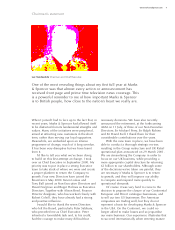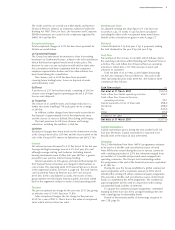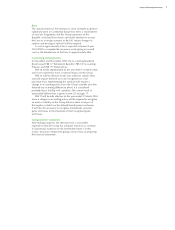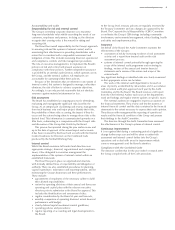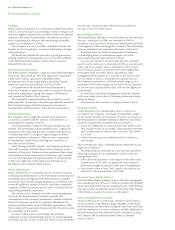Marks and Spencer 2001 Annual Report Download - page 6
Download and view the complete annual report
Please find page 6 of the 2001 Marks and Spencer annual report below. You can navigate through the pages in the report by either clicking on the pages listed below, or by using the keyword search tool below to find specific information within the annual report.
6Marks and Spencer p.l.c.
During the year, both the leading credit agencies reduced
the Group’s long-term credit ratings: Standard & Poor’s to AA-
and Moody’s to A2.
In April of this year, Standard & Poor’s further reduced the
Group’s long-term rating to A and the short-term rating to A1.
The short-term rating with Moody’s remains at P1.
Share buy-back
Shareholder approval was given at the July 2000 AGM to buy
back up to 10% of issued shares. During the financial year,
10,619,272 shares (representing 0.4% of issued share capital)
were purchased in the market for a total consideration of
£20.3m, at an average price of 190.8p. This was undertaken
in order to generate shareholder value.
Balance sheet
The Group balance sheet consolidates Retailing and Financial
Services businesses which have very different characteristics.
The salient figures are disaggregated below:
Retail & Financial Services balance sheets 1 April 2001
Financial Total
Retailing Services Group
2001 2001 2001
£m £m £m
Fixed assets 4,162.4 14.8 4,177.2
Stocks 472.5 – 472.5
Loans & advances to customers – 2,259.2 2,259.2
Other debtors 295.1 75.0 370.1
Trade & other creditors (1,138.5) (201.7)(1,340.2)
Net cash/(debt) 369.4 (1,647.2)(1,277.8)
Net assets 4,160.9 500.1 4,661.0
Loans and advances to customers have increased to £2.3bn
(last year £2.1bn). Within this, £1.7bn relates to personal lending
with the balance representing Chargecard debt.
Treasury policy and financial risk management
The Board approves treasury policies and senior management
directly controls day-to-day operations.
The Group’s financial instruments, other than derivatives,
comprise borrowings, cash and liquid resources and various
items, such as trade debtors and trade creditors, that arise
directly from its operations. The main purpose of these financial
instruments is to raise finance for the Group’s operations.
The Group’s Treasury also enters into derivatives transactions,
principally interest rate and currency swaps, forward foreign
currency contracts and forward rate agreements. The purpose
of such transactions is to manage the interest rate and currency
risks arising from the Group’s operations and financing.
It has been and remains the Group’s policy that no trading
in financial instruments shall be undertaken.
The main financial risks faced by the Group relate to interest
rates, foreign exchange rates, liquidity, counterparty and the
financial risks associated with the Financial Services operation.
The policies and strategies for managing these risks are
summarised as follows:
(a) Interest rate risk
As the majority of debt currently finances the operation of
Financial Services (see point (e) below), current Group policy
is to maintain the majority of its debt as floating rate (currently
95%) and this is achieved with the help of interest rate swaps
and forward rate agreements.
(b) Foreign currency risk
Currency exposure arising from exports from the UK to overseas
subsidiaries has been managed by using forward currency
contracts to hedge between 80% and 100% of sales for periods
averaging 10 to 15 months forward. Following the announced
possible sale or closure of the majority of the overseas
subsidiaries during the next financial year, sales forecasts have
been adjusted and an appropriate level of hedging put in place.
Imports are primarily contracted in sterling and only economic
exposures arise. In future, the Group will be increasing the
proportion of imports contracted in local currencies and a
policy is in place for the hedging of these exposures, principally
using forward currency contracts.
The Group does not use derivatives to hedge balance sheet
and profit and loss account translation exposures. Where
appropriate, borrowings are arranged in local currencies to
provide a natural hedge against overseas assets.
(c) Liquidity risk
The objective is to ensure a mix of funding methods offering
flexibility and cost effectiveness to match the needs of the
Group. Operating subsidiaries are financed by a combination
of retained profits, bank borrowings, commercial paper and
medium term notes. Commercial paper issuance is backed
by committed bank facilities totalling £425.0m.
(d) Counterparty risk
The objective is to reduce the risk of loss arising from default
by counterparties. The risk is managed by using a number of
banks and allocating each a credit limit according to credit
rating criteria. These limits are reviewed regularly by senior
management. Dealing mandates and derivative agreements
are agreed with the banks prior to deals being arranged.
(e) Financial Services division
Interest rate exposures for the Financial Services division
are managed, as far as practical, by matching the periods of
borrowings and their interest basis with that of the customer
debt. Interest rate swaps are used to convert fixed income from
personal loan customers to short-term variable income to match
short-term variable rate borrowings.
The details of derivatives and other financial instruments
required by FRS 13 ‘Derivatives and Other Financial Instruments:
Disclosures’, are shown in notes 18, 21 and 23 to the accounts.
Financial review

